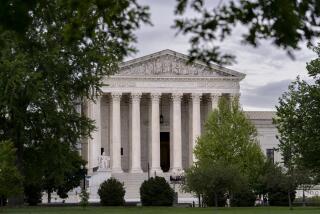High Court to Rule on 2 States’ Displays of 10 Commandments
- Share via
WASHINGTON — The Ten Commandments monument that stands just outside the Texas Capitol begins with the words, “I am the Lord thy God. Thou shalt have no other gods before me.” The Bill of Rights, the first 10 amendments to the U.S. Constitution, begins with the words, “Congress shall make no law respecting an establishment of religion.”
On Wednesday, the U.S. Supreme Court will consider two cases on whether a government’s decision to prominently display the Ten Commandments violates the command in the 1st Amendment.
Since the mid-20th century, the justices have said governments at all levels must abide by the 1st Amendment. They have tackled many other church-state controversies, but only once have they taken up the Ten Commandments.
In that 1980 ruling, the court struck down a Kentucky law that required the posting of the commandments in all the classrooms of the state’s public schools. “The Ten Commandments are undeniably a sacred text in the Jewish and Christian faiths,” and the law requiring their display “is plainly religious in nature,” the court said.
Since then, new disputes have arisen over monuments and stone carvings of Moses and the tablets, which adorn hundreds of courthouses and government buildings, some dating back a century or more.
In the 1950s, even Hollywood played a role in this issue. Producer Cecil B. DeMille, looking to promote his 1956 epic “The Ten Commandments,” joined forces with the Fraternal Order of Eagles to install several hundred granite monuments of the Ten Commandments outside city halls and county courthouses across the nation. Some towns invited actors Charlton Heston, who played Moses, and Yul Brynner, who played the pharaoh, to speak at the dedications. Typically, the displays depicted the Protestant version of the commandments, not the Catholic or Jewish versions.
More recently, the American Civil Liberties Union has filed a series of lawsuits challenging such monuments on the grounds that they amount to a government-sponsored promotion of religion. Two of those cases, from Texas and Kentucky, are now before the high court.
Last year, a U.S. appeals court in the Midwest struck down the posting of the Ten Commandments inside several county courthouses in eastern Kentucky. These displays are “blatantly religious,” the court said.
About the same time, a U.S. appeals court in the South upheld the 6-foot-tall granite monument of the Ten Commandments outside the Texas Capitol in Austin. In 1961, the state chapter of the Fraternal Order of Eagles presented the monument for the benefit of the “youth of Texas.”
Lawyers who follow church-state disputes do not expect a clear-cut ruling that either upholds or strikes down all public displays of the Ten Commandments. Judging from earlier cases, the manner in which the commandments are displayed could be key to the outcome. If they are presented as part of a historical exhibit, for example, they might pass muster.
“Context counts,” says Jay Sekulow, counsel for the American Center for Law and Justice, who supports the Texas monument and the Kentucky displays.
In the Texas case, the Capitol grounds also have monuments honoring the “Heroes of the Alamo,” Confederate soldiers, the Texas Rangers, Texas cowboys, early pioneers and the soldiers of America’s wars in the 20th century.
“We are not persuaded that a reasonable viewer touring the Capitol and its grounds, informed of its history and its placement, would conclude that the state is endorsing the religious message” of the Ten Commandments, the appeals court said in upholding the Texas monument.
But in Kentucky, an effort to add historical context to the Ten Commandments displays by surrounding them with copies of the Declaration of Independence, the Mayflower Compact and “The Star-Spangled Banner” failed to satisfy the appellate courts.
Sekulow says he is confident the Supreme Court will not outlaw all displays of the Ten Commandments on or around government buildings. Otherwise, the justices would have to order the “sandblasting” of their own building, he said.
High above the courtroom where the justices meet are marble carvings of “great lawgivers of history.” There are 18 in all, and one depicts Moses holding two tablets with engravings in Hebrew.
A veteran of church-state litigation, Sekulow jokes about the need to satisfy the “two-reindeer” rule. He is referring to a 1984 ruling in which the high court narrowly upheld a depiction of Christ’s birth in a public park in Pawtucket, R.I., because it also featured reindeer and a sleigh, a Santa Claus house, and other secular symbols of the holidays.
Five years later, the court struck down another city’s more solemn depiction of Christ’s birth. It was erected on the grand staircase of the city-county building in Pittsburgh. With no reindeer or Santa in the surroundings, the baby Jesus was shown with Mary, Joseph and the three wise men. This display was undeniably religious, the majority concluded.
Only Justice Sandra Day O’Connor was in the majority in both rulings, and not surprisingly, the attorneys in the Ten Commandments case have geared their arguments to win her vote. She says the government violates the 1st Amendment when a “reasonable observer” would think its actions “endorse” a particular religion or a religious message.
Her opinions have inspired lawyers on all sides of the issue to speak on behalf of the mythical “reasonable observer.”
“No reasonable observer could discern an endorsement of religion” from either the Kentucky or Texas displays, Bush administration lawyers said in their briefs to the court.
The 1st Amendment “permits the inclusion of passive religious symbols in broader historical and cultural displays,” they argued. Moreover, the Ten Commandments have played a role as a historical source of law in England and the United States, they said.
“Acknowledging the historic fact of those faith traditions’ weighty influence ... is not the same as endorsing those religions,” the lawyers argued.
But ACLU lawyers say the defenders of the Ten Commandments are straining to obscure the obvious.
“The Ten Commandments are a religious symbol and express a religious message,” they said. Officials give them a prominent display, not to teach history, but to endorse the religious message. “The reasonable observer” entering the Kentucky courthouse would see the commandments on the wall and “view them as symbolically endorsing religion,” they added.
“The government is not supposed to be for religion or against religion,” said University of Texas law professor Douglas Laycock, an expert in church-state law who is not directly involved in the cases. “They say the message is about law, not about endorsing religion. But ‘I am the Lord, thy God’ doesn’t sound like law. It sounds like religion.”
Not even opponents of the Ten Commandments government displays call for the removal of all traces of Moses and his commandments from public buildings.
“A reasonable observer might be more likely to understand the government’s asserted secular message if the Ten Commandments monument is installed as part of a larger display depicting various sources of law,” wrote Duke University law professor Erwin Chemerinsky, who is representing the Texas man who challenged the state’s monument. “The frieze on the wall of the Supreme Court is exactly this type of permissible display.”
The justices will hear arguments Wednesday in the two cases, Van Orden vs. Perry and McCreary County, Ky., vs. ACLU, and issue a ruling by late June.
More to Read
Sign up for Essential California
The most important California stories and recommendations in your inbox every morning.
You may occasionally receive promotional content from the Los Angeles Times.














